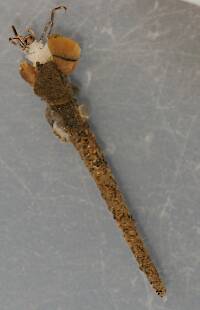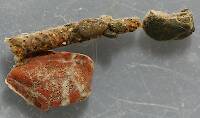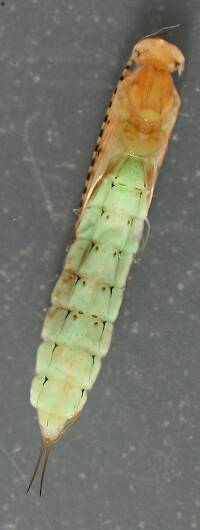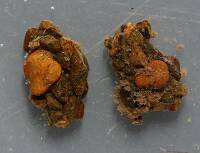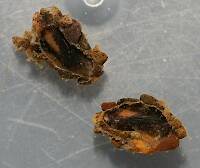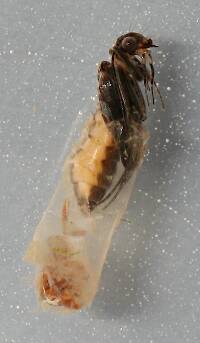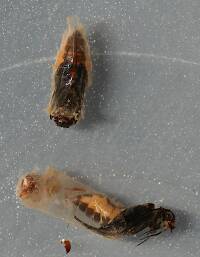
Salmonflies
Pteronarcys californica
The giant Salmonflies of the Western mountains are legendary for their proclivity to elicit consistent dry-fly action and ferocious strikes.
Featured on the forum

Troutnut is a project started in 2003 by salmonid ecologist Jason "Troutnut" Neuswanger to help anglers and
fly tyers unabashedly embrace the entomological side of the sport. Learn more about Troutnut or
support the project for an enhanced experience here.
PghFly on Apr 7, 2012April 7th, 2012, 5:35 am EDT
While reading about the hatching process the statement that, "The dun wriggles out onto the surface, where its wings fill with fluid hydraulically and allow it to take flight. (In contrast to the common myth of mayflies needing time to "dry their wings,"" jumped out at me (http://www.troutnut.com/hatch/4/Insect-Ephemeroptera-Mayflies).
I am new to fly fishing this year and have just been soaking up information. I am curious if anyone has any other references to this. Most everything else I see talks about them "drying" their wings and/or simply resting to build up the strength needed for flight.
I am new to fly fishing this year and have just been soaking up information. I am curious if anyone has any other references to this. Most everything else I see talks about them "drying" their wings and/or simply resting to build up the strength needed for flight.
Lastchance on Apr 7, 2012April 7th, 2012, 6:49 am EDT
I was always taught they are drying their wings, too. We need a further explanation from one of these experts.
Entoman on Apr 7, 2012April 7th, 2012, 9:33 am EDT
Hi Guys,
As an adult, the mayfly's only mission is a two fold one; to escape its aquatic environment, and to reproduce. Some complete their adult cycle in a few hours, some need a few days or more. Their mouth parts are totally atrophied and they take in no nourishment. Their glistening wings and shiny bodies are designed for the hovering dance of their aerial mating behavior, not escaping predators or chasing down food as with other insects. The males have further adapted to this purpose with the addition of long forelegs to assist in balance and gripping of the females as they copulate. The problem is these morphological adaptions would make it very difficult to emerge mid-stream and they never would have occurred if not for the mayfly's unique two stage adult development. This allowed them to adapt very well to the two different needs of the adult stages.
The first stage or subimago (dun) has the primary purpose of getting itself out of it's aquatic environment. If it can't accomplish that, the rest becomes pointless. Ever wondered why duns are duller looking than spinners? Well, the dun's entire exterior is densely covered with water-repellant microtrichia (microscopic hairs). These are lost in the final molt to imago (spinner).
When it's cold out and the mayflies are taking longer to "dry their wings", they are really just taking longer to fill with fluid for unfurling and becoming stiff enough for flight. They are actually quite water repellent in the dun stage. If they weren't, they'd have a heck of a time escaping the surface tension of the meniscus.
As an adult, the mayfly's only mission is a two fold one; to escape its aquatic environment, and to reproduce. Some complete their adult cycle in a few hours, some need a few days or more. Their mouth parts are totally atrophied and they take in no nourishment. Their glistening wings and shiny bodies are designed for the hovering dance of their aerial mating behavior, not escaping predators or chasing down food as with other insects. The males have further adapted to this purpose with the addition of long forelegs to assist in balance and gripping of the females as they copulate. The problem is these morphological adaptions would make it very difficult to emerge mid-stream and they never would have occurred if not for the mayfly's unique two stage adult development. This allowed them to adapt very well to the two different needs of the adult stages.
The first stage or subimago (dun) has the primary purpose of getting itself out of it's aquatic environment. If it can't accomplish that, the rest becomes pointless. Ever wondered why duns are duller looking than spinners? Well, the dun's entire exterior is densely covered with water-repellant microtrichia (microscopic hairs). These are lost in the final molt to imago (spinner).
When it's cold out and the mayflies are taking longer to "dry their wings", they are really just taking longer to fill with fluid for unfurling and becoming stiff enough for flight. They are actually quite water repellent in the dun stage. If they weren't, they'd have a heck of a time escaping the surface tension of the meniscus.
"It's not that I find fishing so important, it's just that I find all other endeavors of Man equally unimportant... And not nearly as much fun!" Robert Traver, Anatomy of a Fisherman
PaulRoberts on Apr 7, 2012April 7th, 2012, 10:12 am EDT
Exactly. "Drying the wings" is a somewhat anthropomorphic/"terrestrio-morphic" thought I think; As if mayflies come out wet and need to dry off.
PghFly on Apr 7, 2012April 7th, 2012, 11:01 am EDT
Thanks for the comments and detail! SO, (after looking up "anthropomorphic" :-), when talking about
"....its wings fill with fluid hydraulically",
we are not really talking about them "taking in" water from the outside, but rather the time it takes their bodily fluids to re-distribute into the newly emerged wings. Is that accurate?
"....its wings fill with fluid hydraulically",
we are not really talking about them "taking in" water from the outside, but rather the time it takes their bodily fluids to re-distribute into the newly emerged wings. Is that accurate?
Entoman on Apr 7, 2012April 7th, 2012, 11:06 am EDT
I'm not sure what you're getting at regarding anthropomorphism and water coming from outside, but yes, the rest of your comment is pretty much the case, though I think this particular "bodily fluid" may be specialized and alterd rather than redistributed. "Drying it's wings" is an acceptable metaphor still used in angling literature as is "mating ritual". Even though not technically accurate, they are much more poetic.:)
"It's not that I find fishing so important, it's just that I find all other endeavors of Man equally unimportant... And not nearly as much fun!" Robert Traver, Anatomy of a Fisherman
PghFly on Apr 7, 2012April 7th, 2012, 12:19 pm EDT
And I certainly appreciate the poetic value! Thanks again for clarifying.
Konchu on Apr 27, 2013April 27th, 2013, 5:51 am EDT
I could be wrong, but I think they are pumping hemolymph (an insect's combination of blood & lymphatic fluid, which is typical of animals with open circulatory systems) into their wings, and that pressure is what helps them to unfold. Exposure to air helps the outside parts to harden after molting. This latter part is a sort of drying. This is my understanding over coffee (without checking in a book).
Oldredbarn on Apr 27, 2013April 27th, 2013, 9:09 am EDT
This is my understanding over coffee (without checking in a book).
Luke...Throw in a few custard-filled's and I'm on my way...You do pretty well for only being in to your first cup! :)
This and Kurt's "water-repellant microtrichia" should be just about enough for me to handle this morning and I've already had my second cup of Earl Grey...
Spence
"Even when my best efforts fail it's a satisfying challenge, and that, after all, is the essence of fly fishing." -Chauncy Lively
"Envy not the man who lives beside the river, but the man the river flows through." Joseph T Heywood
"Envy not the man who lives beside the river, but the man the river flows through." Joseph T Heywood
Entoman on Apr 27, 2013April 27th, 2013, 9:43 am EDT
Luke -
So, it isn't a colorless liquid similar to molting fluid? It's the same as what's found in their open circulatory systems?
Yes, chitin hardening post molt is an important part of the process, and should probably be given more explanation than a simple reference to "firming." Thanks, I'll edit the hatch page.
The point trying to be made is that the surface of the dun's body and wings are quite dry and hydrophobic. Unlike a wet towel hung in the breeze, there isn't an evaporative process (drying) going on, H20 or otherwise. The fact that chitin hardening could be described as a sort of drying is misconstrued by many to mean the dun is wet from water on it's exterior surfaces, either from exposure to the currents or as residue from eclosion.
So, it isn't a colorless liquid similar to molting fluid? It's the same as what's found in their open circulatory systems?
Yes, chitin hardening post molt is an important part of the process, and should probably be given more explanation than a simple reference to "firming." Thanks, I'll edit the hatch page.
The point trying to be made is that the surface of the dun's body and wings are quite dry and hydrophobic. Unlike a wet towel hung in the breeze, there isn't an evaporative process (drying) going on, H20 or otherwise. The fact that chitin hardening could be described as a sort of drying is misconstrued by many to mean the dun is wet from water on it's exterior surfaces, either from exposure to the currents or as residue from eclosion.
"It's not that I find fishing so important, it's just that I find all other endeavors of Man equally unimportant... And not nearly as much fun!" Robert Traver, Anatomy of a Fisherman
Konchu on May 1, 2013May 1st, 2013, 6:29 pm EDT
I should understand more about this external, so-called drying process, post-molt, but it may be more akin to polymerization than to drying proper. Molting fluid I think is different from what I was referring to before: the yellowish green fluid I've seen coursing internally through the veins of the beast as she unfurls her new wings. I've assumed this is hemolymph. I have not really researched it, I must admit. I've preferred to spend the time admiring the process; when I lose the ability to stand in awe and wonder, I need to hang up my net. I actually thought about making a video of it this spring.
Entoman on May 3, 2013May 3rd, 2013, 9:34 am EDT
Luke -
That is my understanding as well.
Thanks for expanding on your answer regarding what sort of bodily fluid is in the wing veins. Can hemolymph (analogous to blood) be clear? The reason I ask is because the veins of many duns (and especially spinners) appear to have a clear liquid in them, if any. Perhaps it drains out once the wings are hardened?
Now that would be something to see!
...so-called drying process, post-molt, but it may be more akin to polymerization than to drying proper.
That is my understanding as well.
Thanks for expanding on your answer regarding what sort of bodily fluid is in the wing veins. Can hemolymph (analogous to blood) be clear? The reason I ask is because the veins of many duns (and especially spinners) appear to have a clear liquid in them, if any. Perhaps it drains out once the wings are hardened?
I actually thought about making a video of it this spring.
Now that would be something to see!
"It's not that I find fishing so important, it's just that I find all other endeavors of Man equally unimportant... And not nearly as much fun!" Robert Traver, Anatomy of a Fisherman
Quick Reply
Related Discussions
Topic
Replies
Last Reply
2
Nov 12, 2012
by Entoman
by Entoman
1
Sep 9, 2008
by GONZO
by GONZO







